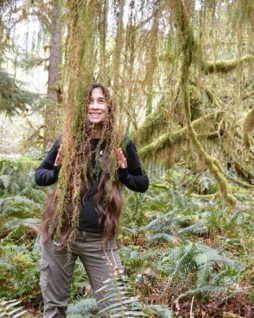
Washington native Korena Mafune is a PhD student at the University of Washington in Drs. Daniel and Kristiina Vogt’s lab. Korena researches in the Olympic Penninsula in Washington where she focuses on elucidating the role of adventitious roots and their fungal partners in canopy soils of old-growth Acer macrophyllum (big leaf maple). In these temperate rainforests, canopy soils form from epiphytic mats on branches decomposing over time. Some dominant tree species have adapted to develop adventitious rooting systems in these arboreal soils. They are prevalent in old-growth forests throughout the Olympic Peninsula, where stands have been recorded to accumulate 200,000 m^3/ha of canopy soil volume. These unique forests are experiencing more seasonal extremes, such as wetter winters and drier summers, and are known for their temporal stability. Korena is specifically interested in exploring if fungi associating with adventitious rooting systems in canopy soils are acting as adaptive facilitators to environmental change. The research field of canopy soil is relatively young, so it is very important to lay the building blocks for understanding these complex ecosystems. Her specific research aims to identify fungi associating with adventitious and forest floor rooting systems of the same host trees, identify if root fungal communities are unique to the respective soil habitat, and if they shift throughout the experimental drought manipulations. She will also be exploring phosphorus and nitrogen nutrient fluxes, while gathering soil microclimatic data throughout the experimental manipulation. The research group has also been working to create a protocol that will allow fungal community analysis using the MinIon Nanopore Sequencer. They have successfully ran the MinIon, are currently analyzing the barcoded library, and troubleshooting to create an even stronger protocol that will increase accuracy. Korena’s research is funded by the Daniel E. Stuntz Memorial Foundation, and various local mycological societies (Puget Sound Mycological Society (Ben Woo Scholarship), Oregon Mycological Society, and Sonoma Mycological Society). She is the recipient of the Ben Hall Conservation Genetics Award, and the MSA Forest Fungal Ecology Award. Korena plans to continue researching canopy soil ecosystems in academia, ideally ending in a research scientist or professor position in the Pacific Northwest.
What is your favorite fungus and why?
How can there be just one?!? I love Cantharellus subalbidus, because when the goldens are shy, they always greet me with a plentiful forage. I also love the appearance of Boletus (Xerocomellus) xelleri, and I always get a kick out of having my students feel the consistency of Dacrymyces.
What is your favorite thing about fungi?
The parallel evolution of land plants and symbiotic fungi, and the fact that certain host trees have adapted to have fungal-root relations in canopy soils. Would plants have evolved to be so complex without fungi?! Would we even be here without them?! I also love that a majority of all land plants are holding hands with their best friends (mycorrhiza). Fungi rule the world!!
Who is your mycology role model?
I have met so many enthusiastic mycologists over the last several years. Joe Ammirati has really helped me. I came into this project from an ecological background, and his input has allowed me to step back and better comprehend the extreme complexity of plant-fungal evolution.
Any great stories from field work?
Too many to count, but here are a couple funny stories:
One time when I was leading an introductory fungal field trip, I instructed the students to go forage for some mushrooms to ID, and an overly enthusiastic student grabbed a disguised fuzzy piece of dog poop before I had the chance to give the warning. When I said, ‘Oh no, drop it’, a student said ‘like it’s hot?’. We all had a good laugh.
My current undergraduate assistant has a peculiar talent in which he perfectly imitates a monkey call. So now it comes normal to play Marco-Polo with monkey calls vs. using the walkies, when we are locating each other in field.
While on the topic of monkey-ing around, I was climbing in the Peruvian Amazon a few summers ago, and a family of Howler monkeys decided to investigate. They ended up coming into the tree right across from me ~20’ away, and just stared at me for about 10 minutes. They had a little baby with them, and it was so cute. I was semi nervous about them feeling threatened, but maybe being up on their level helped me out.
What do you like to do in your free time? What are your hobbies?
I train martial arts/boxing about 5-6 days a week, which takes up most of my free time. Other than that, I love spending time with my family and fur babies (a husky and two kitties), swimming in my favorite Washington waterholes, hula hooping, and foraging during the right seasons. I also love food, whether it is cooking it, eating it, or both.


Leave a Reply